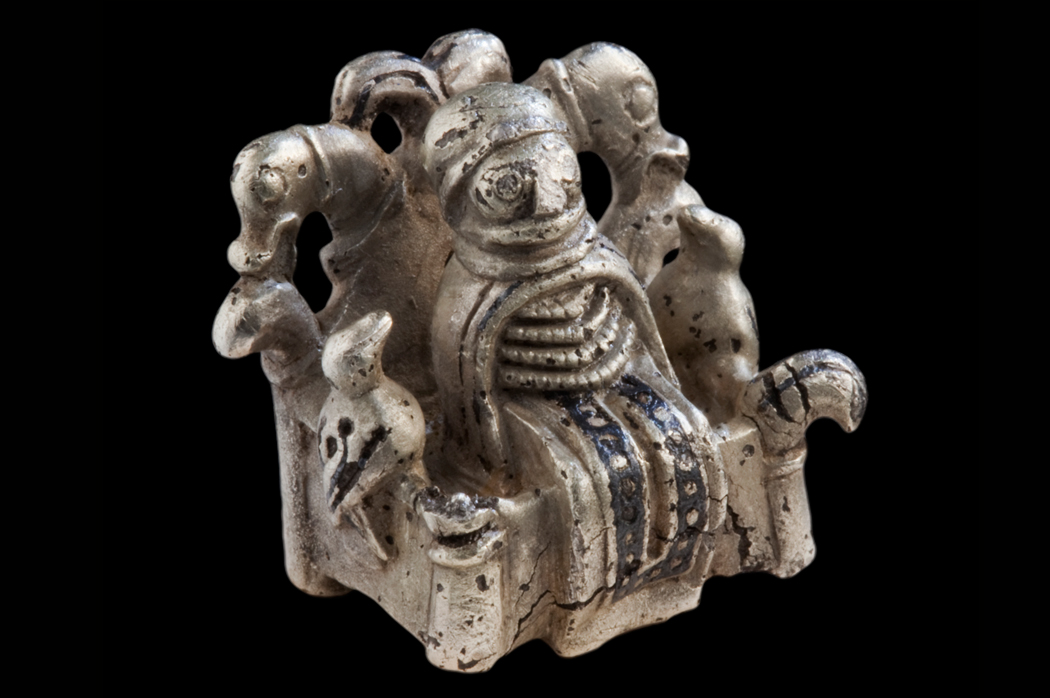Is the silver figurine from Lejre representing Odin? Freya? Or perhaps a völva, a Viking sorceress? Many interpretations have been put forward
Major excavations during 2008 – 09 in Lejre, the old Royal stronghold in Eastern Denmark, yielded evidence of one of the largest mead-halls ever excavated. Another intriguing find was a small silver statuette with niello inlay, no more than 1.72 cm x 19.8 cm x 12.4 cm. Based on the style the figurine has been dated to c. AD 900. According to the official understanding, the figurine shows the god Odin, sitting on his throne, Lidskjalv. On each side of Odin from Lejre are two birds, perhaps the ravens, Hugin and Munin, and behind him are his wolves, Geri and Freki. Around his neck – and below a moustache – is presumably the goldring, Draupner, which spawns 8 new goldrings every 9th night. As behoves Odin he is shown with a missing or at least roving eye. As the myth goes he had to give Mimer an eye in exchange for the chance of drinking himself to unlimited wisdom in the well of Mimer.
Female
However, due to some odd details this identification of the small figurine as Odin has been contested. Foremost the details of “his” dress – what might be understood not as a helmet but as easily as a hairnet, the long garment covering the feet, the cape rather than the mantel or cloak, the pearls around the neck and finally what perhaps is an apron – are believed by the archaeologist Ulla Mannering to signal female gender. However, Tom Christensen, who has identified the figurine as Odin points to the fact that European iconography in the 10th century presented kings in long robes and seated on thrones. He has floated the interpretation that the figure might even be a syncretistic presentation of a Christian emperor – God’s representative on earth, dressed up as Odin.
Transgender
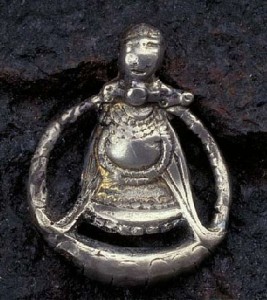
However, many of the femaile elements may also be found found on a small pregnant figurine from Aska, which deci-
dedly is female, but also seems to sport “wandering” or maybe even “roving” eyes.
This has prompted Elisabeth Arwill-Nordbladh to a detailed study of other figurines from the same time and milieu. She has concluded that the archaeological material shows that the ocular theme was part of various performative practices connected with prophesying and “future” gazing and not just a feature clinging to the myths about Odin.
She concludes that the Vikings seem to have moved in a world where ambiguous gender pared with impaired sight might play a part in the negotiations of “body-normative practices”. In her own words “This corporal exceptionality in relation to (today’s) notions of body-normativity may imply that the Viking Age abled body sometimes was extended to include reduced visual capacity. The processing of both gender-normativity and body-normativity in one and the same precious item, may imply that the high-ranked setting of Lejre included performative practices that were negotiating both hetero-normative and body-normative hegemonic orders.”
A less “postmodern wording” may formulate it a bit differently. As old age approaches in a Viking setting, ambiguous “clothing” in the form of blankets and visual impairment caused by cataract may not be considered signs of actual impairment. Old people – even old chieftains, who could no longer swing a sword – might still be of some “prophetic” value. Further: It is evident from the Nordic Mythological writings from a later age that Odin was considered a shapeshifter, well-versed in shifting from male to female to animal.
Völva
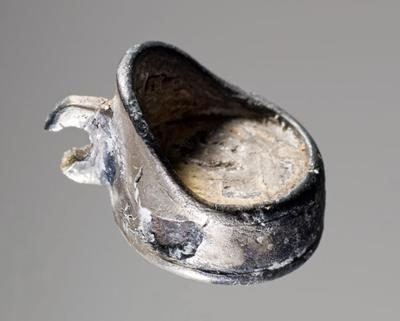
Recently another attempt to understand the enigmatic figurine was floated by Bettina Sommer and Morten Warmind. They have proposed that it may instead represent a pre-Christian prophetess, a völva and that the figurine – which is hollow – might originally have been fitted to the top of a staff of one of these Viking sorceresses.
First off all, they note that there is no scriptural evidence, which points to an identification of the seat of Odin – Lidskjalv – as a throne per se. Rather, it might be understood as another name for Valhalla and not a chair or throne set apart. Rather, Odin would have been seated at a bench in the hall marked out by the ornamental posts, the ondvegissúlur. Secondly the arguments concerning the female character of the dress and the inconclusive understanding of the ring around the mouth as a moustache leads in another direction.
Perhaps, posits the authors, it is significant what we know Völvas explicitly were the ones sitting on thrones – set apart – when performing their sorceries and ceremonies. Thus in the Edda poem, the Vǫluspá, the sorceress explains how she met with Odin “sitting out alone”; here he came to look her in the eyes . (Ein sat hon úti, þá er inn aldni kom, yggjungr ása, ok í augu leit; v. 28)
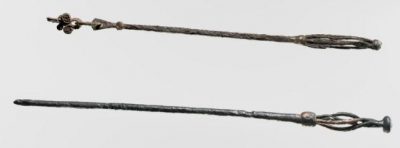
Later folklore describes how sorceresses were known to position themselves outside at crossroads – presumably on chairs or thrones; or alternatively, they seated themselves high up on scaffolds as it is described in Eiriks Saga Rauda how “The women formed a ring round about, and Thorbjorg ascended the scaffold and the seat prepared for her enchantments. Then sang Gudrid the weird-song in so beautiful and excellent a manner, that to no one there did it seem that he had ever before heard the song in voice so beautiful as now.”
It is tempting to understand the figurine as depicting a drugged Völva, who is “sitting out” and waiting with her rowing eyes for Odin to meet up with her and tell her and her audience the future. It is also tempting to understand the tiny figurine – which is meant to be seen both from the front and the back – as an embellishment, which might have been placed at the top of the ritual staffs, which we know Völvas carried around and which have been found in a number of old women’s graves.
SOURCES
A Silver Figurine from Lejre
By Tom Christensen
In: Danish Journal of Archaeology (2013) vol 2, no 1, pp.65 -78
Man or Woman? – perception of gender through costume
By Ulla Mannering
In: Danish Journal of Archaeology (2013) vol 2, no 1, pp 79 – 86
Negotiating normativities – ‘Odin from Lejre’ as challenger of hegemonic orders
By Elisabeth Arwill-Nordbladh
Danish Journal of Archaeology: Published online: 28 May 2013
DOI:10.1080/21662282.2013.791131
Óðinn from Lejre — or?
Bettina Sommer and Morten Warmind
In: Nvmen (2015) Vol 62, pp.627 – 638
READ MORE:
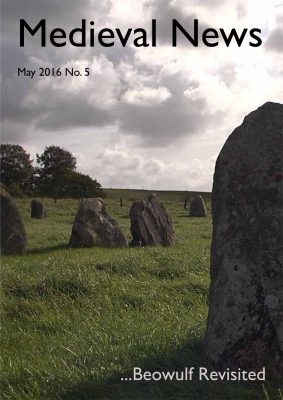 ‘Medieval News’ from May 2016 brings you stories about Lejre in the land of the Scyldings and Beowulf, which is about to be unlocked. But it also shares a lot of notices about upcoming conferences, new books etc….
‘Medieval News’ from May 2016 brings you stories about Lejre in the land of the Scyldings and Beowulf, which is about to be unlocked. But it also shares a lot of notices about upcoming conferences, new books etc….
SEE MORE:
A video with a 360o presentation of the figurine may be seen at Roskilde Museum, where it is exhibited.
FEATURED PHOTO:
Odin from Lejre © Ole Malling/ Roskilde Museum
